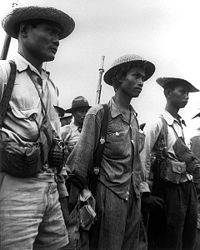Juan Pajota
This article needs additional citations for verification. (February 2013) |
Juan Pajota | |
|---|---|
Captain Juan Pajota | |
| Born | c.1914 Nueva Ecija, Philippines |
| Died | 1976 United States |
| Allegiance | |
| Service | USAFFE, 45th Infantry Regiment, Philippine Scouts,91st Div PA |
| Years of service | 1941-1946 |
| Rank | |
| Battles / wars | World War II |
| Awards | Bronze Star |
Captain Juan Pajota (c.1914 – 1976) was involved in the Raid at Cabanatuan, an action which took place in the Philippines on 30 January 1945 by US Army Rangers and Filipino guerrillas and resulted in the liberation of more than 500 American prisoners of war (POWs) from a Japanese POW camp near Cabanatuan.[1]
World War II

A local from Nueva Ecija, he joined the USAFFE guerrillas during the retreat from Bataan. Later he became leader of the guerrillas.[2]
Raid at Cabanatuan
The Raid at Cabanatuan was a rescue of Allied prisoners of war (POWs) and civilians from a Japanese camp near Cabanatuan City, in the Philippines. On January 30, 1945, during World War II, United States Army Rangers, Alamo Scouts, and Filipino guerrillas liberated more than 500 from the POW camp.
Under the command of Captain (later promoted Major) Juan Pajota, who coordinated support, this force was responsible for the roadblock at the Cabu River bridge that totally destroyed the Japanese 359th Independent Infantry Battalion. Without the guerrilla’s support it is unlikely that the raid would have been as successful or even succeeded at all.[3]
Military Tactics
His intimate knowledge of the enemy's activity, the local people and terrain proved to be crucial to the rescue. His instructions to the local villagers to muzzle their dogs to quell barking at passing American troops was timely and prudent. His recommendation that the mission (Raid at Cabanatuan) be moved back 24 hours to Lt. Col.Henry A. Mucci due to heavy Japanese activities proved to be a wise move.[4] Another great idea of Capt. Pajota was a flyover of an American plane to divert the attentions of the enemies and distract their attention while the troops are moving.[5] His troops held back the advancing Japanese tanks and reinforcements and prevented them from crossing the Cabu Bridge to engaged the rescuers and POWs. He had procured about 50 carabaos (water buffalo) carts caravan that was used to transport the prisoners to friendly lines that saves the lives of many prisoners.[2]
Death
In 1976 Juan Pajota came to the U.S. to file for citizenship. A year later he was still waiting for citizenship. He died of a heart attack a few days before his case was resolved.
Popular Culture
Captain Juan Pajota appeared as a character for the 2005 John Dahl film, The Great Raid. He was played by Filipino actor Cesar Montano.[6]
References
- ^ "Juan Pajota and Filipino Contributions to the Raid". pbs.org.
- ^ a b Oxford, Gordon L. THE CABANATUAN PRISON RAID: THE PHILIPPINES 1945 (PDF). Osprey Publishing. p. 64.
- ^ King, Michael J. (1985). Rangers: Selected Combat Operations in World War II. Combat Studies Institute.
- ^ Encyclopedia of World War II (WWII) Battles (Mobi History). Jan 1, 2007.
{{cite book}}:|first=missing|last=(help) - ^ Barchers, Suzanne I. (2010). War Stories for Readers Theatre: World War II. Libraries Unlimited. ISBN 978-1-59158-750-7.
- ^ MORROW, PAUL (16 June 2006). "AN INTERVIEW WITH GREAT RAID DIRECTOR, JOHN DAHL". Pilipino Express.
